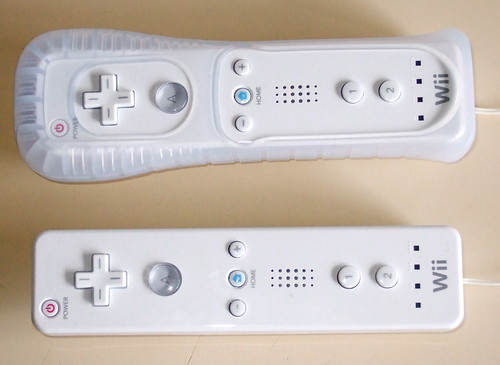Fall Prevention and Wii
Many Wii games can be played from a seated position. However, sometimes the goals of therapy include getting a patient to stand and balance. For a patient whose balance may be in question, the therapist may wish to use a gait belt. Another option would be to use parallel bars for support or for safety, or using a walker with therapist at the side. For example, while the Wii balance board is very sensitive to shifts in weight, it can still be effectively used to train balance while the user relies partly on upper-body strength to support the lower body.
When using the balance board, be sure it is not on a slippery surface and that other people will not trip over it. The balance board is white and may be difficult to see on a white or light colored floor, especially for patients with low vision. This potential risk can be mitigated by placing the balance board on top of a non-stick mat, such as a yoga mat, in a darker color. For patients at risk for falls, Wii use that involves standing should always be supervised.
Infection control and Wii
If the Wii equipment is shared in a clinic setting, it must be appropriately cleaned between uses to prevent potential transfer of any pathogens (germs).
To fully clean the remote, the protective safety jacket should be removed from the remote. The jacket can be immersed for cleaning, but the remote can NOT be immersed. The remote itself should be wiped with disinfectant solution readily available in the clinic (use the same wiping method as for similar plastic items). The Wii remote strap can be removed and washed as well. (See the photo below of a Wii remote with safety jacket and with jacket removed.)

Photo by frostova on Flickr
Also, users can wear latex gloves while handling the remote for extra precaution.
Injury Prevention and Wii
Therapists incorporating Wii into a therapeutic plan should use the same strategies that they would use if a person had started a new sport. For example, if the patient has been bothered by a wrist or elbow in the past, the therapist may consider using ice and monitoring a patient to prevent overuse. Because of the "fun" element involved in Wii, overuse may be of particular concern. Also, therapists should make sure all movements are being done correctly and that patients do not compensate for a weak muscle with a stronger muscle group.
Avoiding injury to others or damage to equipment with the Wii
In the early days of the Wii, anecdotes of Wii bowlers accidentally throwing the Wii remote through a television screen abounded. The Wii remote's safety strap and safety instructions given at the start of each Wii session and game, as well as the new safety jacket, should help prevent this type of damage (or injury that could result if the remote hit another person).
Always clear the area of potential hazards or obstructions before using the Wii, make sure he safety strap is secured to the player's wrist, and use the padded secure-grip safety jacket on the remote (see the photo above of the remote with and without the safety jacket). Also, follow all safety precautions given by the Wii software.



2 comments:
These are good safety tips. I must do some of these sometimes.
Very nice work you done .I just found a website where you find and download all kind of software just like getintopc.
Post a Comment